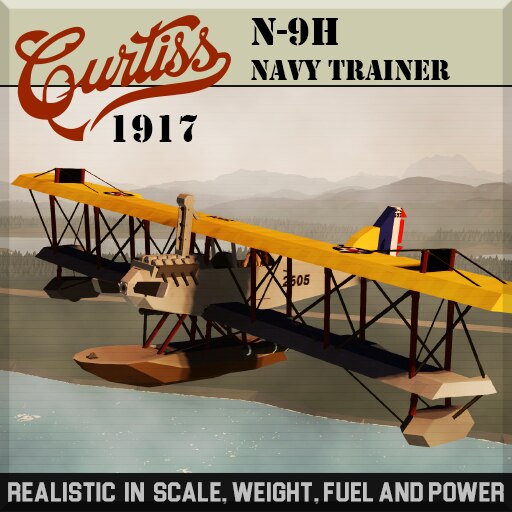Curtiss N-9H Floatplane
Originally this was going to be an update to Curtiss N-9C but changes were too many, thus making it mostly a new design. As a result of having realistic weight with far more details, it needs artificial buoyancy and also it has more powerful engine than N-9C variant.
(Realistic in scale, weight, fuel and power)
HISTORY
The Curtiss N-9H was a floatplane variant of the Curtiss JN-4 "Jenny" military trainer used during World War I by the United States Navy. As a seaplane, the N-9 was equipped with a single central pontoon mounted under the fuselage. A small float was fitted under each wingtip of the biplane. – Wikipedia
The N-9H designation was official, the letter identifying the 150 hp Wright-Hispano engine. This installation differed considerably from the N-9C. The cylinder banks were exposed as on the N-9C but were different in appearance. The use of a large spinner over the propeller hub precluded the use of a nose radiator, so the cooling was done by a large column-like radiator that projected well above the wing. The Navy tested some N-9Hs With the 150 hp Curtiss K-6 engine but did not adopt the new powerplant. Cost was $10,050 less GFE. – Curtiss Aircraft 1907-1947
Other notes and features:
- Keyboard and HOTAS throttle options
- Always takeoff against wind if there is wind
- Well optimized by having only a few sub-bodies where it’s necessary such as creating artificial buoyancy.
- Fuel remaining time and max range instruments needs stable flight in order to work
- Range can be increased to 140 miles (225 km) at 0.7 throttle (set elevator trim to -0.1 for that)
- Hand grenade, pistol and binocular are on the left of front seat (observer)
- Fire extinguisher, welder torch, first aid kit and flare are behind and under the rear seat (pilot)
- Refuel and recharge connectors are on the location where lower wing’s leading edge connects to fuselage.
Below are the specifications of the vehicle I made for Stormworks. To see real specifications of this vehicle, look for Wikipedia or other sources.
– PNG to XML Paint tool: http://rising.at/Stormworks/paint.php
– Engine Thrust Test and Power Estimation: https://steamcommunity.com/sharedfiles/filedetails/?id=2732688766
Tags: ww1




